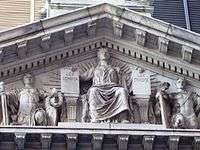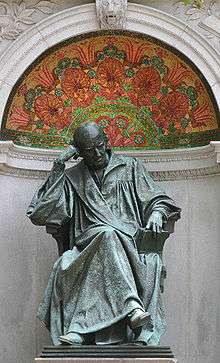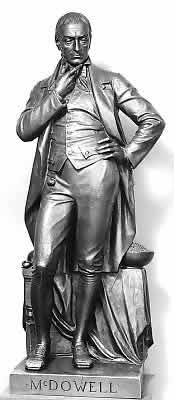Charles Henry Niehaus

Charles Henry Niehaus (January 24, 1855 – June 19, 1935), was an American sculptor.
Education
Niehaus was born in Cincinnati, Ohio to German parents.[1] He began working as a marble and wood carver, and then gained entrance to the McMicken School of Design in Cincinnati. He studied at the Royal Academy in Munich, Germany (1877–81). The effect of the German study was that he retained much of the Neo-Classical flavor in his art while most other sculptors of his generation were drawn towards Beaux-Arts realism.
Career
He returned to America in 1881. By virtue of being a native Ohioan, he was commissioned to sculpt two statues of the recently assassinated President Garfield; one for Cincinnati (Garfield's home city), and the other, in another pose, for the National Statuary Hall Collection at the United States Capitol. He moved to Rome, Italy, where he worked on the commissions, and made a study of ancient sculpture. He modeled three major male nudes during his years in Rome, including The Scraper (1883) and Caestus (1883-85). He returned to New York City in 1885, and opened a studio.[2]
In 1887, he created a statue of Ohioan William Allen, also for Statuary Hall. In later years, he was to place statues of Oliver P. Morton of Indiana (1900), John J. Ingalls of Kansas (1905), Zachariah Chandler of Michigan (1913), George W. Glick of Kansas (1914), Ephraim McDowell of Kentucky (1929), and Henry Clay of Kentucky (1929) in the collection.
Monuments by Niehaus can be found in many American cities. Several of the works authored by him are equestrian statues. As was the case with other sculptors of his day he also fashioned a fair amount of architectural sculpture.
In 1900 Niehaus married noted horticulturalist Regina Armstrong and moved to New Rochelle, New York, where they lived until his death in 1935.[3]
Selected works


- James A. Garfield, Piatt Park, Cincinnati, Ohio, 1882-87.
- The Scraper (Athlete Using a Strigil), Brookgreen Gardens, Murrells Inlet, South Carolina, 1883.[4]
- Caestus, Metropolitan Museum of Art, New York City, 1883-85.[5]
- Bas-relief panel of Surrender of the Hessians, Trenton Battle Monument, Trenton, New Jersey, 1891–1893. William Rudolf O'Donovan sculpted the colossal George Washington statue atop the monument, and statues of two Continental soldiers flanking the entrance. Thomas Eakins modeled two other bas-relief panels.
- Moses, Main Reading Room, Library of Congress, Washington, D.C., 1894.[6]
- Edward Gibbon, Main Reading Room, Library of Congress, Washington, D.C., 1894.[7]
- Samuel Hahnemann Monument, Scott Circle, Washington, D.C., 1896-1900.
- Hackley Park, Muskegon, Michigan:
- Bust of Charles Hackley, 1890.
- Abraham Lincoln Monument, 1900. Replicas of Niehaus's Abraham Lincoln are at the Buffalo History Museum in Buffalo, New York,[8] and at Library Park in Kenosha, Wisconsin.
- David Farragut Monument, 1900.[9]
- William McKinley Monument, 1902.[10]
- Bust of Robert Blum, Cincinnati Art Museum, Cincinnati, Ohio, ca. 1900.
- The Driller, Edwin Drake Memorial, Woodlawn Cemetery, Titusville, Pennsylvania, 1901.
- Equestrian Statue of General Forrest, Nathan Bedford Forrest Grave, Forrest Park, Memphis, Tennessee, 1901-05.
- Apotheosis of St. Louis, Forest Park, St. Louis, Missouri, 1906.
- William McKinley, McKinley Memorial Mausoleum, Canton, Ohio, 1907. Niehaus also modeled the lunette bas-relief over the entrance.
- Benjamin Harrison, Indiana World War Memorial Plaza, Indianapolis, Indiana, 1908.
- James W. Beardsley, Beardsley Park, Bridgeport, Connecticut, 1909.[11]
- John Paul Jones, John Paul Jones Memorial, West Potomac Park, Washington, D.C., 1912. Niehaus's plaster original is at the United States Naval Academy, Annapolis, Maryland.
- Oliver Hazard Perry (1915–16), Front Park, Buffalo, New York.[12][13]
- Orpheus (Francis Scott Key Monument), Fort McHenry National Monument, Baltimore, Maryland, 1916-22.[14] Nickname: Orpheus with the Awkward Foot.
- Planting the Standard of Democracy in Honor of Newark's Soldiers, World War I Memorial, Lincoln Park, Newark, New Jersey, 1923.
- Hackensack War Monument, The Green, Bergen County Court House, Hackensack, New Jersey, 1924.[15]
- At least 30 Civil War monuments and several World War I memorials.
United States Capitol


Niehaus had eight statues in the National Statuary Hall Collection at the United States Capitol in Washington, D.C., a record for a sculptor. However, in 2003, Kansas replaced his George W. Glick statue with one of Dwight D. Eisenhower, and in 2011, Michigan replaced his Zachariah Chandler statue with one of Gerald R. Ford. His remaining six statues are still more than any other sculptor has in the Hall.[16]
- James A. Garfield, 1886.
- William Allen, 1887.
- Oliver Hazard Perry Morton, 1900.
- John James Ingalls, 1905.
- Zachariah Chandler, 1913 (removed 2011).
- George W. Glick, 1914 (removed 2003).
- Henry Clay, 1929.
- Ephraim McDowell, 1929.
There are also two busts by Niehaus in other collections:
- Bust of James A. Garfield, United States Senate Art Collection, ca. 1885.[17]
- Bust of Daniel D. Tompkins, United States Senate Vice Presidential Bust Collection, 1891.[18]
Architectural sculpture
- Connecticut State Capitol, Hartford, Connecticut:
- Bust of Joel Barlow, ca. 1885.
- Bust of George Berkeley, ca. 1885.
- Statue of John Davenport, 1889.
- Statue of Thomas Hooker, 1889.
- Bust of Reverend Jonathan Edwards, 1895.
- Bust of John Trumbull, 1895.
- Bas-relief of Hooker's March, 1895.
- Bas-relief of Davenport Preaching at New Haven, 1895.
- Astor Memorial Doors (south doors), Trinity Church, New York City, 1895.
- Two tympana, Thomas Jefferson Building, Library of Congress, Washington, D.C., ca. 1896.
- Pedimental sculpture of The Triumph of Law, Appellate Court House, New York City, 1896–1900.
- Pedimental sculpture, Kentucky State Capitol, Frankfort, Kentucky, 1907.
Gallery
 James A. Garfield (1882–87), Piatt Park, Cincinnati, Ohio.
James A. Garfield (1882–87), Piatt Park, Cincinnati, Ohio. Samuel Hahnemann Monument (1896-1900), Scott Circle, Washington, D.C.
Samuel Hahnemann Monument (1896-1900), Scott Circle, Washington, D.C. Abraham Lincoln Monument (1900), Hackley Park, Muskegon, Michigan.
Abraham Lincoln Monument (1900), Hackley Park, Muskegon, Michigan. Bust of Robert Blum (ca. 1900), Cincinnati Art Museum, Cincinnati, Ohio.
Bust of Robert Blum (ca. 1900), Cincinnati Art Museum, Cincinnati, Ohio. Nathan Bedford Forrest (1901–05), Forrest Park, Memphis, Tennessee.
Nathan Bedford Forrest (1901–05), Forrest Park, Memphis, Tennessee.- William McKinley (1907), McKinley Memorial Mausoleum, Canton, Ohio.
- James W. Beardsley (1909), Beardsley Park, Bridgeport, Connecticut.
 John Paul Jones (1912), John Paul Jones Memorial, Washington, DC.
John Paul Jones (1912), John Paul Jones Memorial, Washington, DC. Niehaus with his model for Orpheus, (Francis Scott Key Monument) (1916–22), Baltimore, Maryland.
Niehaus with his model for Orpheus, (Francis Scott Key Monument) (1916–22), Baltimore, Maryland. World War I Monument (1923), Lincoln Park, Newark, New Jersey.
World War I Monument (1923), Lincoln Park, Newark, New Jersey. Ephraim McDowell (1929), United States Capitol, Washington, DC.
Ephraim McDowell (1929), United States Capitol, Washington, DC.
Notes
- ↑ Clark, S. J. (1912). Cincinnati, the Queen City, 1788-1912, Volume 2. The S. J. Clarke Publishing Company. p. 19. Retrieved 2013-05-20.
- ↑ 1911 Encyclopedia Britanica.
- ↑ "Regina Armstrong (NY Times & Standard Star articles provided)". Home.comcast.net. Archived from the original on 2014-02-02. Retrieved 2014-08-10.
- ↑ The Scraper from SIRIS.
- ↑ Caestus from Metropolitan Museum of Art.
- ↑ Moses from Library of Congress.
- ↑ Edward Gibbon from Library of Congress.
- ↑ Buffalo Lincoln from Buffalo History Museum.
- ↑ Farragut Monument from SIRIS.
- ↑ McKinley Monument from SIRIS.
- ↑ Beardsley statue from CT Monuments.
- ↑ Commodore Perry from SIRIS.
- ↑ "Commodore Perry". Novan.com. Archived from the original on 2015-02-20. Retrieved 2014-08-10.
- ↑ Special to The New York Times. (1916-05-18). "Key Memorial Approved, NY Times". New York Times. Retrieved 2014-08-10.
- ↑ Hackensack War Monument from SIRIS.
- ↑ National Statuary Hall Collection from Architect of the Capitol.
- ↑ Garfield bust from U.S. Senate.
- ↑ Tompkins bust from U.S. Senate.
References
- Bzdak, Meredith Arms, photographs by Douglas Peterson, Public Sculpture in New Jersey: Monuments to Collective identity, Rutgers University Press, New Brunswick, New Jersey, 1999
- Connecticut State Capitol Statuary, The League of Women Voters of Connenticut: Education Fund
- Hardin Campen, Richard N., Outdoor Sculpture in Ohio: A Comprehensive Overview of Outdoor Sculpture in Ohio, Mid-Nineteenth Century to the Present, West Summit Press, Chagrin Falls, Ohio, 1980
- Kvaran, Einar Einarsson, Architectural Sculpture of America, unpublished manuscript
- Opitz, Glenn B , Editor, Mantle Fielding’s Dictionary of American Painters, Sculptors & Engravers, Apollo Book, Poughkeepsie NY, 1986
- Proske, Beatrice Gilman, Brookgreen Gardens Sculpture, Brookgreen Gardens, South Carolina, 1968
-
 Chisholm, Hugh, ed. (1911). "Niehaus, Charles Henry". Encyclopædia Britannica (11th ed.). Cambridge University Press.
Chisholm, Hugh, ed. (1911). "Niehaus, Charles Henry". Encyclopædia Britannica (11th ed.). Cambridge University Press.
External links
| Wikimedia Commons has media related to Charles Henry Niehaus. |
-
 "Niehaus, Charles Henry". Encyclopedia Americana. 1920.
"Niehaus, Charles Henry". Encyclopedia Americana. 1920.